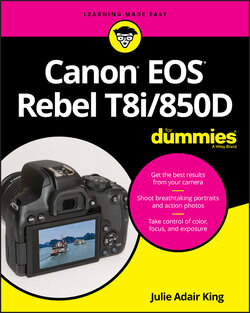Читать книгу Canon EOS Rebel T8i/850D For Dummies - King Julie Adair, Julie Adair King - Страница 14
Topside controls
ОглавлениеYour virtual tour begins on the top of the camera, shown in Figure 1-6. Here are the items of note:
On/Off/Movie mode switch: As outlined in the preceding section, setting the switch to the movie-camera icon turns on the camera and sets it to movie-recording mode. Move the switch to On for still photography.Even when the switch is in the On position, the camera automatically goes to sleep after a period of inactivity to save battery power. To wake the camera up, press the shutter button halfway and release it. See the information related to the Auto Power Off setting, found in the section “Setup Menu 2,” later in this chapter, for help adjusting the timing of the automatic shutoff.
Mode dial: Rotate this dial to select an exposure mode, which determines whether the camera operates in fully automatic, semi-automatic, or manual exposure mode when you take still pictures. Chapter 2 introduces you to the various exposure modes.
Viewfinder adjustment dial: Use this dial to adjust the viewfinder focus to your eyesight, as outlined in the preceding section.
Main dial: As its name implies, this dial is central to many camera functions, from scrolling through menus to changing certain shooting and playback settings.FIGURE 1-6: Here’s a guide to controls found on top of the camera. On some menu screens, you see a symbol that resembles the top half of a dial with notches around the edge, as shown in Figure 1-7. That symbol indicates that you use the Main dial to adjust the setting. On some screens curved arrows appear near the Main dial symbol. In Figure 1-7, you see one arrow under the Main dial symbol and another on the left side of the screen. When using the touchscreen, you can tap those arrows to adjust the setting instead of using the Main dial.FIGURE 1-7: The notched half-circle symbol tells you to use the Main dial to adjust the setting.
AF Method/AF Area Selection button: Press this button to access the AF Method and AF Area Selection settings, both related to autofocusing. Chapter 5 explains.
ISO button: True to its name, this button displays a screen where you can adjust the ISO setting, which determines how sensitive the camera is to light. Chapter 4 details this critical setting.
DISP button: This button affects the Quick Control screen, which displays shooting information when you’re taking still pictures. (Check out “Displaying the Quick Control screen,” later in this chapter, for a look.) Normally, the screen appears automatically when you turn the camera on or press the shutter button halfway and release it; the screen then turns off after a period of inactivity. But you can press the DISP button at any time to toggle the screen on and off.
Shutter button: You no doubt already understand the function of this button, but you may not realize that when you use autofocus and autoexposure, you need to use a two-stage process when taking a picture: Press the shutter button halfway, pause to let the camera set focus and exposure, and then press down the rest of the way to capture the image. You’d be surprised how many people mess up their pictures because they press that button with one quick jab, denying the camera the time it needs to set focus and exposure.
Flash hot shoe: Labeled in Figure 1-6, this is the connection for attaching an external flash and other accessories such as flash adapters and the Canon GP-E2 GPS Receiver.
Focal plane indicator: Should you need to know the exact distance between your subject and the camera, the focal plane indicator, labeled in Figure 1-6, is key. This mark indicates the plane at which light coming through the lens is focused onto the camera’s image sensor. Basing your measurement on this mark produces a more accurate camera-to-subject distance than using the end of the lens or some other point on the camera body as your reference point. You might take advantage of this feature when taking pictures for a legal or scientific purpose that requires you to submit the camera-to-subject distance along with the photos.
Speaker: When you play a movie that contains audio, the sound comes wafting through these holes.
Microphone: You can record movie audio via the built-in microphone, which picks up sound from the two holes labeled “Microphone” in Figure 1-6.
